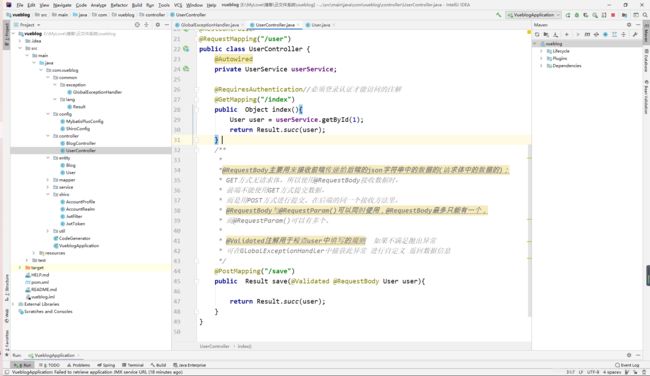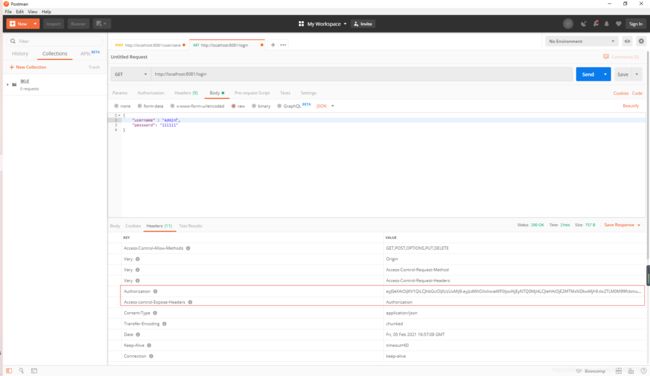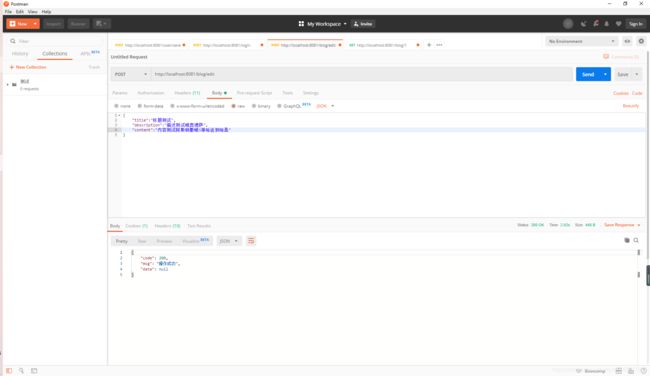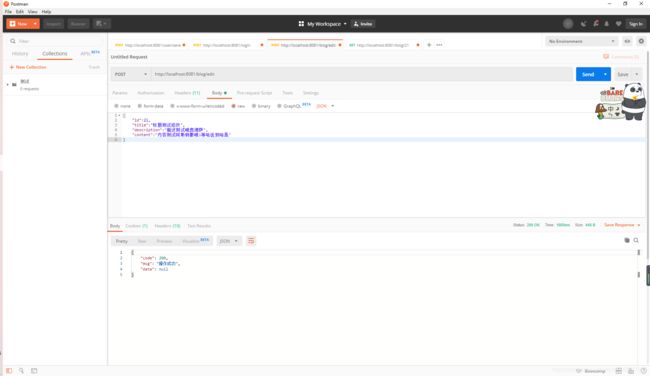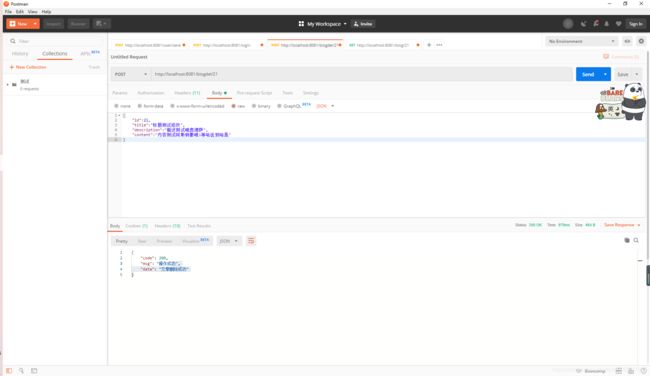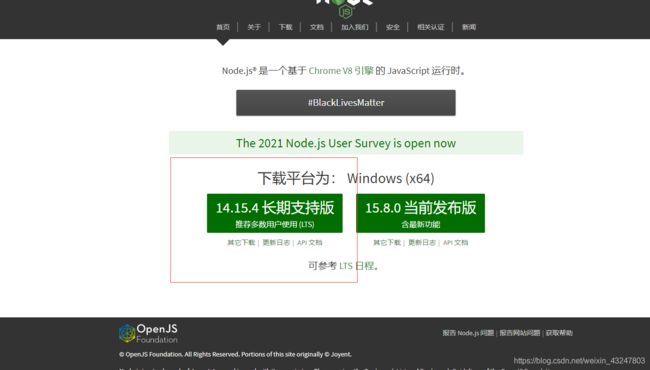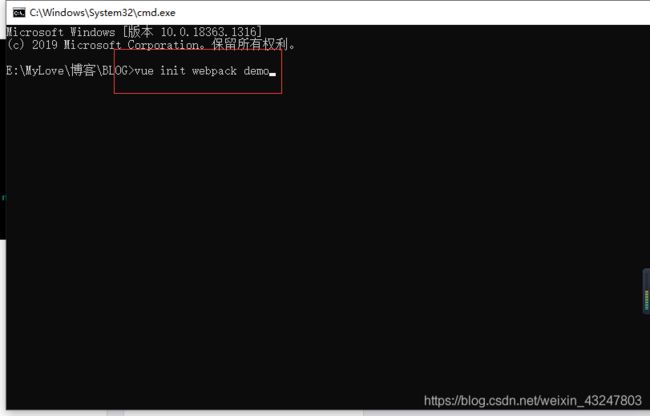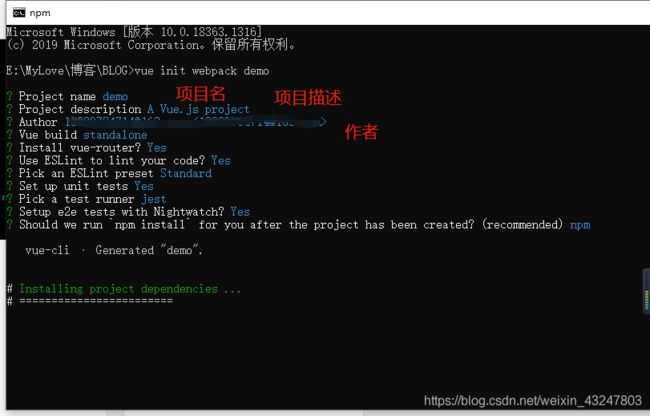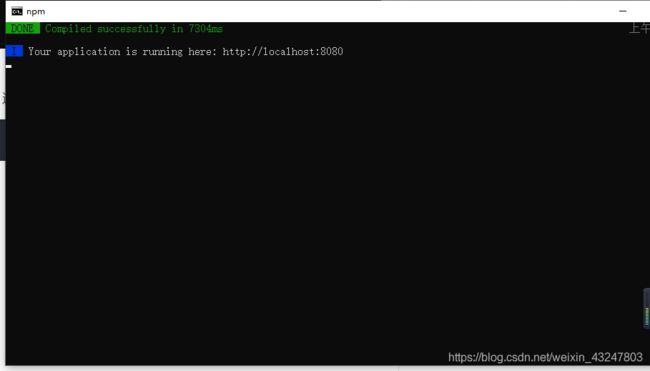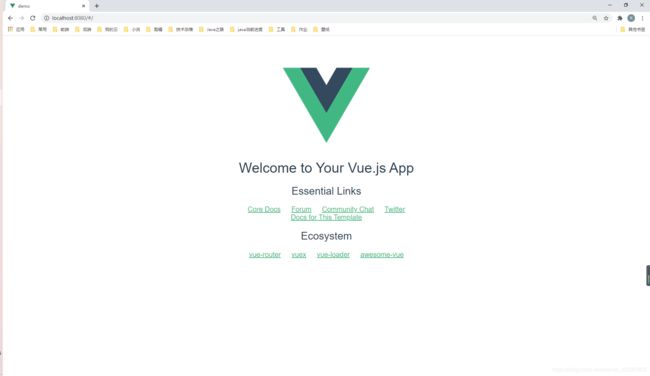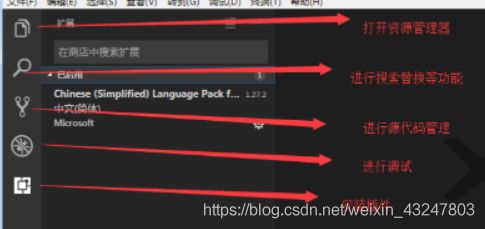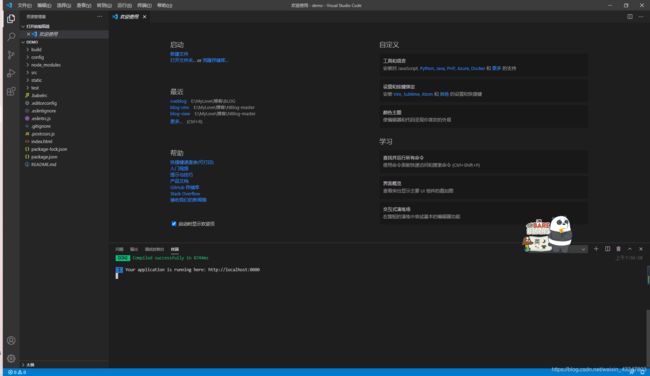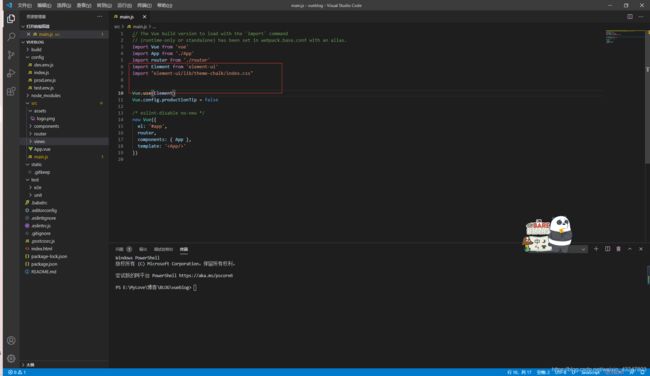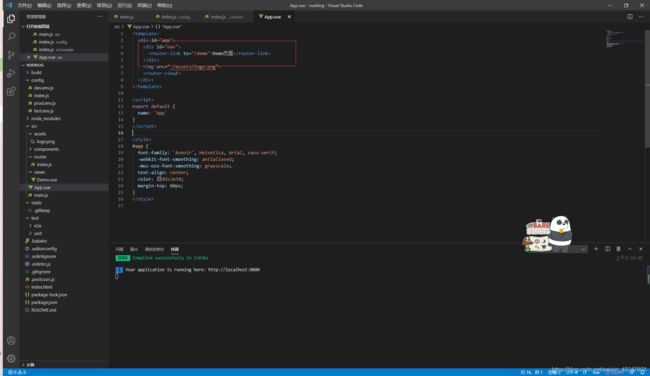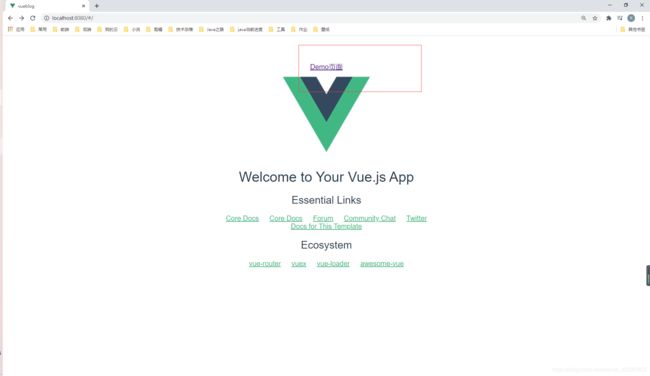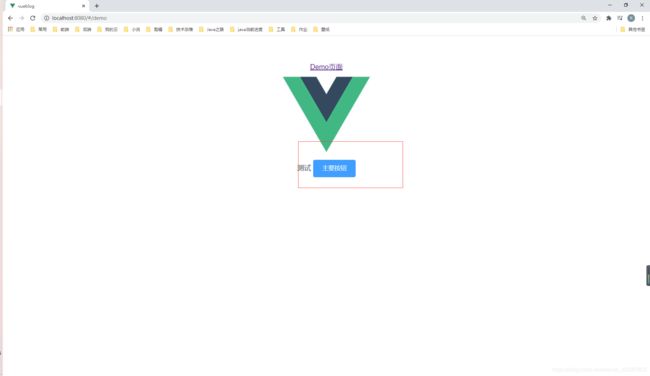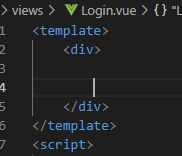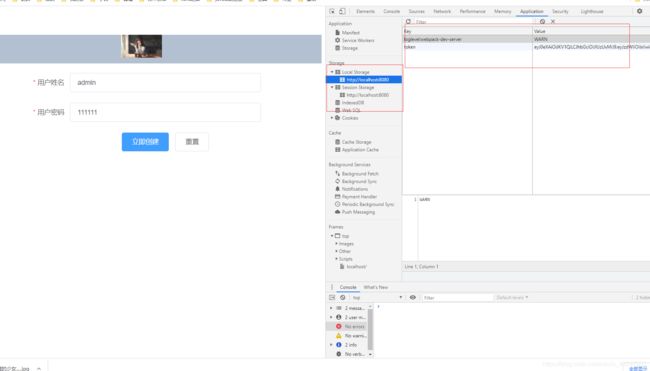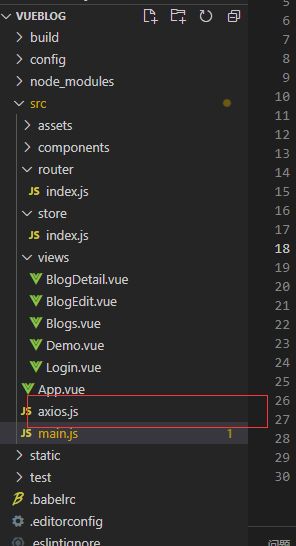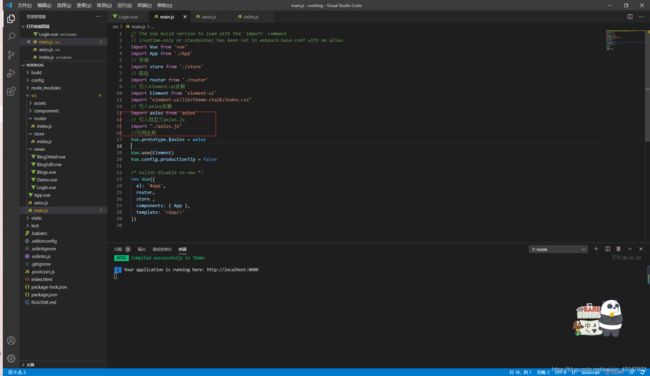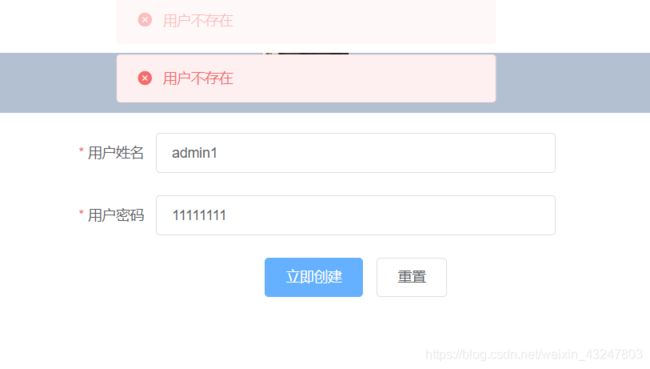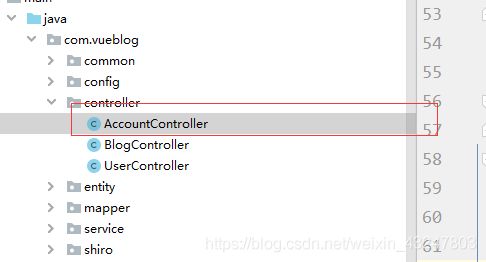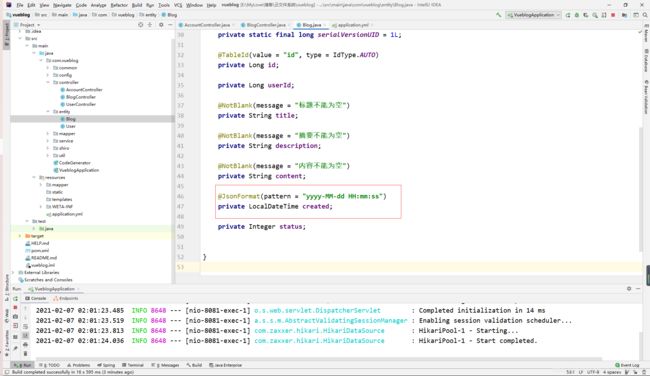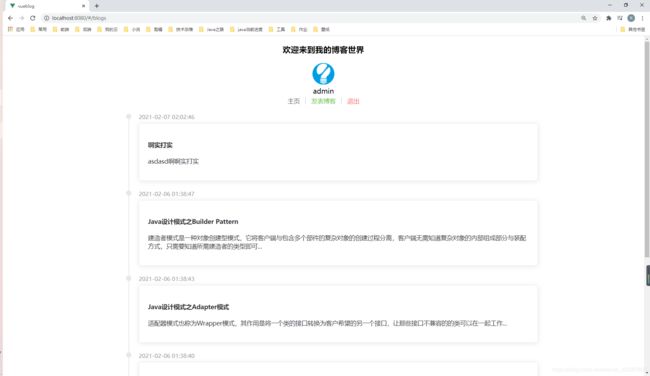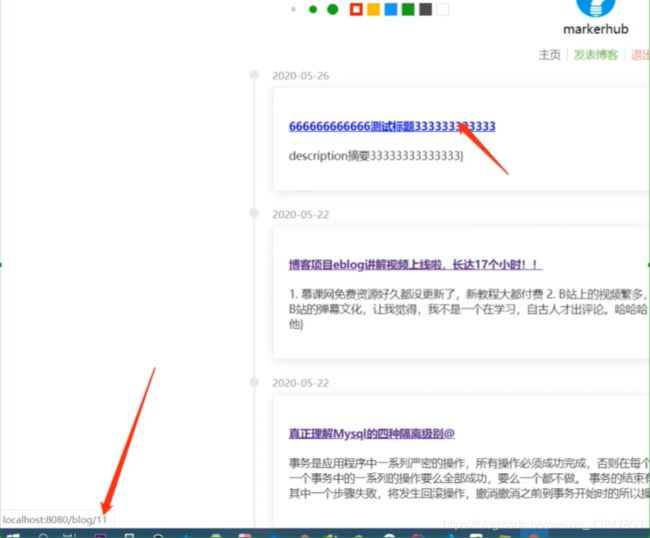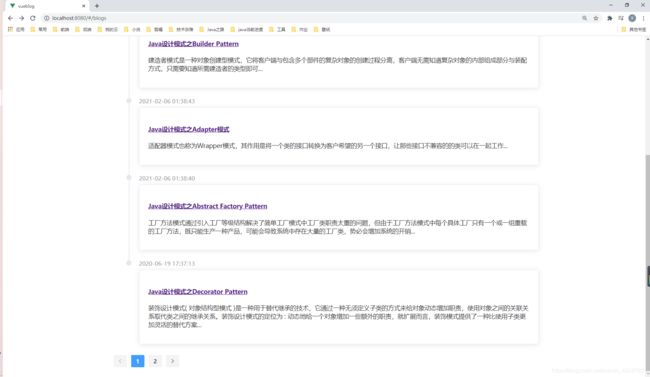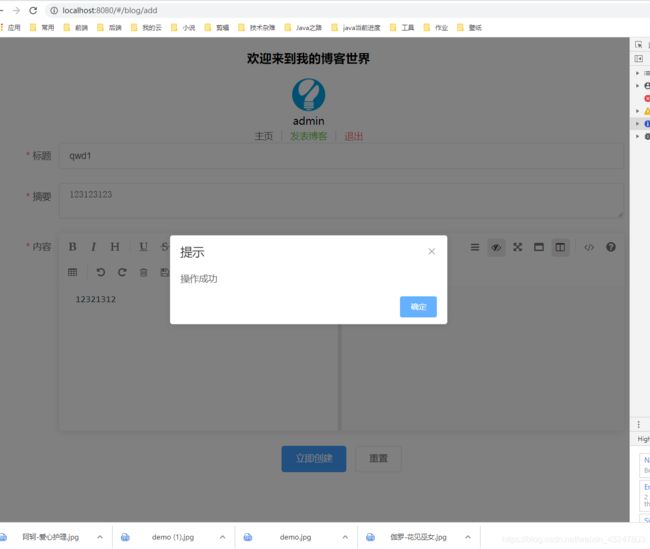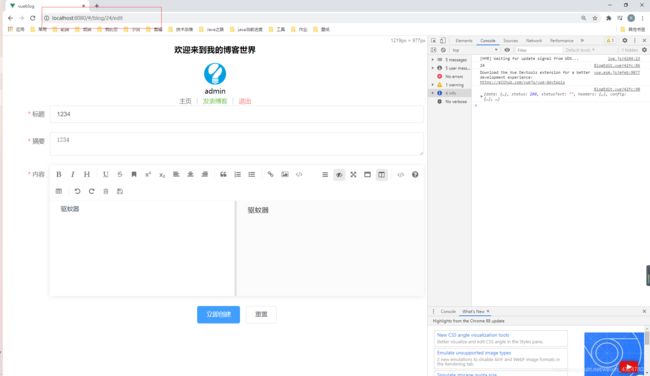springboot+jwt+shiro+vue+elementUI+axios+redis+mysql完成一个前后端分离的博客项目(笔记,帮填坑)
根据B站up主MarkerHub视频制作的一个笔记
我的博客
B站博主链接:
https://www.bilibili.com/video/BV1PQ4y1P7hZ?p=1
博主的开发文档:
https://juejin.cn/post/6844903823966732302
部署视频
https://www.bilibili.com/video/BV17A411E7aE?p=1
up主的部署文档
https://juejin.im/post/6886061338804617229/
开源项目源码 :
up主的:
https://github.com/MarkerHub/vueblog
我的:
https://gitee.com/hntianshu/vueblog
热部署配置:
https://www.cnblogs.com/erlongxizhu-03/p/12193646.html
idea报Could not autowired解决办法:
https://blog.csdn.net/yxm234786/article/details/81460752
ElementUI官方文档
https://element.eleme.cn/#/zh-CN/component/quickstart
PostMan安装包下载
https://blog.csdn.net/weixin_43184774/article/details/100578557
VsCode保存自动格式化样式
https://blog.csdn.net/wang0112233/article/details/90608328
Redis的安装和启动
https://www.cnblogs.com/pretty-sunshine/p/10615287.html
搞定Shiro集成redis实现会话共享
https://blog.csdn.net/m0_46995061/article/details/106751848
nginx官网
http://nginx.org/en/download.html
文章目录
- 简易博客项目(springboot+jwt+shiro+vue+elementUI+axios+redis+mysql)
-
- 第一章 整合新建springboot,整合mybatisplus
-
- 第一步 创建项目(第八步骤就行)+数据库:
- 配置分页MybatisPlusConfig+生成代码(dao 、service、serviceImpl等)
- 第三步 做测试
- 第二章 统一结果封装
- 第三章 Shiro整合jwt逻辑分析
- 第四章 Shiro逻辑开发
- 第五章 异常处理
- 第六章 实体校验
- 第七章 跨域问题
- 第七章 登录接口开发
- 第八章 博客接口的开发
- 后端总结
- 第九章 Vue前端页面开发
-
- 前言
- 环境准备
- 新建项目
- 项目的架构
- vscode前端常用插件推荐,搭建JQuery、Vue等开发环境
-
- **使用vscode打开项目并且运行**
- 安装element-ui
- 补充配置:
- 安装axios
- 页面路由
- 路由中心配置
- 登录页面开发
-
- 登录页面制作
- 配置store
- 登录发起请求 (配置完善store)
- **配置axios拦截**
- 公共组件Header
- 博客编辑(发表)
-
- 安装mavon-editor
- 博客详情和编辑按钮的权限
- 路由权限拦截
- 第十章 其他
- 增加删除文章功能
简易博客项目(springboot+jwt+shiro+vue+elementUI+axios+redis+mysql)
第一章 整合新建springboot,整合mybatisplus
第一步 创建项目(第八步骤就行)+数据库:
https://blog.csdn.net/weixin_43247803/article/details/113622480
修改pom.xml借鉴
4.0.0
org.springframework.boot
spring-boot-starter-parent
2.2.6.RELEASE
com.vueblog
vueblog
0.0.1-SNAPSHOT
vueblog
Demo project for Spring Boot
1.8
org.springframework.boot
spring-boot-starter-web
org.springframework.boot
spring-boot-devtools
runtime
true
mysql
mysql-connector-java
runtime
org.projectlombok
lombok
true
org.springframework.boot
spring-boot-starter-test
test
org.junit.vintage
junit-vintage-engine
com.baomidou
mybatis-plus-boot-starter
3.2.0
org.springframework.boot
spring-boot-starter-freemarker
com.baomidou
mybatis-plus-generator
3.2.0
cn.hutool
hutool-all
5.3.3
io.jsonwebtoken
jjwt
0.9.1
org.springframework.boot
spring-boot-maven-plugin
修改配置文件
# DataSource Config
spring:
datasource:
driver-class-name: com.mysql.cj.jdbc.Driver
url: jdbc:mysql://localhost:3306/vueblog?useUnicode=true&useSSL=false&characterEncoding=utf8&serverTimezone=Asia/Shanghai
username: root
password: 123456
mybatis-plus:
mapper-locations: classpath*:/mapper/**Mapper.xml
server:
port: 8081
创建数据库vueblog然后执行下面命令生成表
DROP TABLE IF EXISTS `m_blog`;
/*!40101 SET @saved_cs_client = @@character_set_client */;
SET character_set_client = utf8mb4 ;
CREATE TABLE `m_blog` (
`id` bigint(20) NOT NULL AUTO_INCREMENT,
`user_id` bigint(20) NOT NULL,
`title` varchar(255) NOT NULL,
`description` varchar(255) NOT NULL,
`content` longtext,
`created` datetime NOT NULL ON UPDATE CURRENT_TIMESTAMP,
`status` tinyint(4) DEFAULT NULL,
PRIMARY KEY (`id`)
) ENGINE=InnoDB AUTO_INCREMENT=21 DEFAULT CHARSET=utf8mb4 COLLATE=utf8mb4_0900_ai_ci;
/*!40101 SET character_set_client = @saved_cs_client */;
DROP TABLE IF EXISTS `m_user`;
/*!40101 SET @saved_cs_client = @@character_set_client */;
SET character_set_client = utf8mb4 ;
CREATE TABLE `m_user` (
`id` bigint(20) NOT NULL AUTO_INCREMENT,
`username` varchar(64) DEFAULT NULL,
`avatar` varchar(255) DEFAULT NULL,
`email` varchar(64) DEFAULT NULL,
`password` varchar(64) DEFAULT NULL,
`status` int(5) NOT NULL,
`created` datetime DEFAULT NULL,
`last_login` datetime DEFAULT NULL,
PRIMARY KEY (`id`),
KEY `UK_USERNAME` (`username`) USING BTREE
) ENGINE=InnoDB AUTO_INCREMENT=2 DEFAULT CHARSET=utf8;
/*!40101 SET character_set_client = @saved_cs_client */;
INSERT INTO `vueblog`.`m_user` (`id`, `username`, `avatar`, `email`, `password`, `status`, `created`, `last_login`) VALUES ('1', 'markerhub', 'https://image-1300566513.cos.ap-guangzhou.myqcloud.com/upload/images/5a9f48118166308daba8b6da7e466aab.jpg', NULL, '96e79218965eb72c92a549dd5a330112', '0', '2020-04-20 10:44:01', NULL);
配置分页MybatisPlusConfig+生成代码(dao 、service、serviceImpl等)
1.0 配置分页
创建MybatisPlusConfig类(创建路径com/vueblog/config)
package com.vueblog.config;
import com.baomidou.mybatisplus.extension.plugins.PaginationInterceptor;
import org.mybatis.spring.annotation.MapperScan;
import org.springframework.context.annotation.Bean;
import org.springframework.context.annotation.Configuration;
import org.springframework.transaction.annotation.EnableTransactionManagement;
@Configuration
@EnableTransactionManagement
@MapperScan("com.markerhub.mapper")
public class MybatisPlusConfig {
@Bean
public PaginationInterceptor paginationInterceptor() {
PaginationInterceptor paginationInterceptor = new PaginationInterceptor();
return paginationInterceptor;
}
}
2.0 生成代码
创建CodeGenerator(在com.vueblog包下面)
**修改对应的数据库:账号密码、数据库名、包配置(ctrl+f可找到对应位置) **
然后运行输入俩表 ,号隔开是多表
package com.vueblog;
import com.baomidou.mybatisplus.core.exceptions.MybatisPlusException;
import com.baomidou.mybatisplus.core.toolkit.StringPool;
import com.baomidou.mybatisplus.core.toolkit.StringUtils;
import com.baomidou.mybatisplus.generator.AutoGenerator;
import com.baomidou.mybatisplus.generator.InjectionConfig;
import com.baomidou.mybatisplus.generator.config.*;
import com.baomidou.mybatisplus.generator.config.po.TableInfo;
import com.baomidou.mybatisplus.generator.config.rules.NamingStrategy;
import com.baomidou.mybatisplus.generator.engine.FreemarkerTemplateEngine;
import java.util.ArrayList;
import java.util.List;
import java.util.Scanner;
// 演示例子,执行 main 方法控制台输入模块表名回车自动生成对应项目目录中
public class CodeGenerator {
/**
*
* 读取控制台内容
*
*/
public static String scanner(String tip) {
Scanner scanner = new Scanner(System.in);
StringBuilder help = new StringBuilder();
help.append("请输入" + tip + ":");
System.out.println(help.toString());
if (scanner.hasNext()) {
String ipt = scanner.next();
if (StringUtils.isNotEmpty(ipt)) {
return ipt;
}
}
throw new MybatisPlusException("请输入正确的" + tip + "!");
}
public static void main(String[] args) {
// 代码生成器
AutoGenerator mpg = new AutoGenerator();
// 全局配置
GlobalConfig gc = new GlobalConfig();
String projectPath = System.getProperty("user.dir");
gc.setOutputDir(projectPath + "/src/main/java");
// gc.setOutputDir("D:\\test");
gc.setAuthor("anonymous");
gc.setOpen(false);
// gc.setSwagger2(true); 实体属性 Swagger2 注解
gc.setServiceName("%sService");
mpg.setGlobalConfig(gc);
// 数据源配置 数据库名 账号密码
DataSourceConfig dsc = new DataSourceConfig();
dsc.setUrl("jdbc:mysql://localhost:3306/vueblog?useUnicode=true&useSSL=false&characterEncoding=utf8&serverTimezone=UTC");
// dsc.setSchemaName("public");
dsc.setDriverName("com.mysql.cj.jdbc.Driver");
dsc.setUsername("root");
dsc.setPassword("123456");
mpg.setDataSource(dsc);
// 包配置
PackageConfig pc = new PackageConfig();
pc.setModuleName(null);
pc.setParent("com.vueblog");
mpg.setPackageInfo(pc);
// 自定义配置
InjectionConfig cfg = new InjectionConfig() {
@Override
public void initMap() {
// to do nothing
}
};
// 如果模板引擎是 freemarker
String templatePath = "/templates/mapper.xml.ftl";
// 如果模板引擎是 velocity
// String templatePath = "/templates/mapper.xml.vm";
// 自定义输出配置
List focList = new ArrayList<>();
// 自定义配置会被优先输出
focList.add(new FileOutConfig(templatePath) {
@Override
public String outputFile(TableInfo tableInfo) {
// 自定义输出文件名 , 如果你 Entity 设置了前后缀、此处注意 xml 的名称会跟着发生变化!
return projectPath + "/src/main/resources/mapper/"
+ "/" + tableInfo.getEntityName() + "Mapper" + StringPool.DOT_XML;
}
});
cfg.setFileOutConfigList(focList);
mpg.setCfg(cfg);
// 配置模板
TemplateConfig templateConfig = new TemplateConfig();
templateConfig.setXml(null);
mpg.setTemplate(templateConfig);
// 策略配置
StrategyConfig strategy = new StrategyConfig();
strategy.setNaming(NamingStrategy.underline_to_camel);
strategy.setColumnNaming(NamingStrategy.underline_to_camel);
strategy.setEntityLombokModel(true);
strategy.setRestControllerStyle(true);
strategy.setInclude(scanner("表名,多个英文逗号分割").split(","));
strategy.setControllerMappingHyphenStyle(true);
strategy.setTablePrefix("m_");
mpg.setStrategy(strategy);
mpg.setTemplateEngine(new FreemarkerTemplateEngine());
mpg.execute();
}
}
第三步 做测试
1.0 UserController类(ctrl+R可全局搜索类)
package com.vueblog.controller;
import com.vueblog.service.UserService;
import org.springframework.beans.factory.annotation.Autowired;
import org.springframework.web.bind.annotation.GetMapping;
import org.springframework.web.bind.annotation.RequestMapping;
import org.springframework.web.bind.annotation.RestController;
/**
* <p>
* 前端控制器
* </p>
*
* @author 深林中的书海
* @since 2021-02-05
*/
@RestController
@RequestMapping("/user")
public class UserController {
@Autowired
private UserService userService;
@GetMapping("/index")
public Object index(){
return userService.getById(1);
}
}
第二章 统一结果封装
这里我们用到了一个Result的类,这个用于我们的异步统一返回的结果封装。一般来说,结果里面有几个要素必要的
- 是否成功,可用code表示(如200表示成功,400表示异常)
- 结果消息
- 结果数据
- Result类(路径com.vueblog.common.lang;)
package com.vueblog.common.lang;
import lombok.Data;
import java.io.Serializable;
@Data
public class Result implements Serializable {
//序列化
private int code; //200是正常 400表示异常
private String msg;
private Object data;//返回数据
//成功
public static Result succ( Object data){
return succ(200,"操作成功",data);
}
//成功
public static Result succ(int code,String msg,Object data){
Result r = new Result();
r.setCode(code);
r.setMsg(msg);
r.setData(data);
return r;
}
//失败
public static Result fail(String msg){
return fail(400,msg,null);
}
//失败
public static Result fail(String msg,Object data){
return fail(400,msg,data);
}
//失败
public static Result fail(int code,String msg,Object data){
Result r = new Result();
r.setCode(code);
r.setMsg(msg);
r.setData(data);
return r;
}
}
- 在UserController 中引用测试
package com.vueblog.controller;
import com.vueblog.common.lang.Result;
import com.vueblog.entity.User;
import com.vueblog.service.UserService;
import org.springframework.beans.factory.annotation.Autowired;
import org.springframework.web.bind.annotation.GetMapping;
import org.springframework.web.bind.annotation.RequestMapping;
import org.springframework.web.bind.annotation.RestController;
/**
*
* 前端控制器
*
*
* @author 深林中的书海
* @since 2021-02-05
*/
@RestController
@RequestMapping("/user")
public class UserController {
@Autowired
private UserService userService;
@GetMapping("/index")
public Object index(){
User user = userService.getById(1);
return Result.succ(200,"操作成功",user);
}
}
- 页面运行效果图 (http://localhost:8081/user/index)
第三章 Shiro整合jwt逻辑分析
考虑到后面可能需要做集群、负载均衡等,所以就需要会话共享,而shiro的缓存和会话信息,我们一般考虑使用redis来存储这些数据,所以,我们不仅仅需要整合shiro,同时也需要整合redis。在开源的项目中,我们找到了一个starter可以快速整合shiro-redis,配置简单,这里也推荐大家使用。
而因为我们需要做的是前后端分离项目的骨架,所以一般我们会采用token或者jwt作为跨域身份验证解决方案。所以整合shiro的过程中,我们需要引入jwt的身份验证过程。
那么我们就开始整合:
我们使用一个shiro-redis-spring-boot-starter的jar包,具体教程可以看官方文档:github.com/alexxiyang/…
- 导入shiro-redis的starter包:还有jwt的工具包,以及为了简化开发,引入hutool工具包。
pom.xml中导入:
<!-- shiro-redis -->
<dependency>
<groupId>org.crazycake</groupId>
<artifactId>shiro-redis-spring-boot-starter</artifactId>
<version>3.2.1</version>
</dependency>
<!-- hutool工具类 -->
<dependency>
<groupId>cn.hutool</groupId>
<artifactId>hutool-all</artifactId>
<version>5.3.3</version>
</dependency>
<!-- jwt 生成工具 校验工具-->
<dependency>
<groupId>io.jsonwebtoken</groupId>
<artifactId>jjwt</artifactId>
<version>0.9.1</version>
</dependency>
- 创建ShiroConfig
文件路径:com/vueblog/config
package com.vueblog.config;
import com.vueblog.shiro.AccountRealm;
import com.vueblog.shiro.JwtFilter;
import org.apache.shiro.mgt.DefaultSessionStorageEvaluator;
import org.apache.shiro.mgt.DefaultSubjectDAO;
import org.apache.shiro.mgt.SecurityManager;
import org.apache.shiro.session.mgt.SessionManager;
import org.apache.shiro.spring.web.ShiroFilterFactoryBean;
import org.apache.shiro.spring.web.config.DefaultShiroFilterChainDefinition;
import org.apache.shiro.spring.web.config.ShiroFilterChainDefinition;
import org.apache.shiro.web.mgt.DefaultWebSecurityManager;
import org.apache.shiro.web.session.mgt.DefaultWebSessionManager;
import org.crazycake.shiro.RedisCacheManager;
import org.crazycake.shiro.RedisSessionDAO;
import org.springframework.beans.factory.annotation.Autowired;
import org.springframework.context.annotation.Bean;
import org.springframework.context.annotation.Configuration;
import java.util.HashMap;
import java.util.LinkedHashMap;
import java.util.Map;
import javax.servlet.Filter;
/**
* shiro启用注解拦截控制器
*/
@Configuration
public class ShiroConfig {
@Autowired
private JwtFilter jwtFilter;
@Bean
public SessionManager sessionManager(RedisSessionDAO redisSessionDAO) {
DefaultWebSessionManager sessionManager = new DefaultWebSessionManager();
sessionManager.setSessionDAO(redisSessionDAO);
return sessionManager;
}
@Bean
public DefaultWebSecurityManager securityManager(AccountRealm accountRealm,
SessionManager sessionManager,
RedisCacheManager redisCacheManager) {
DefaultWebSecurityManager securityManager = new DefaultWebSecurityManager(accountRealm);
securityManager.setSessionManager(sessionManager);
securityManager.setCacheManager(redisCacheManager);
/*
* 关闭shiro自带的session,详情见文档
*/
DefaultSubjectDAO subjectDAO = new DefaultSubjectDAO();
DefaultSessionStorageEvaluator defaultSessionStorageEvaluator = new DefaultSessionStorageEvaluator();
defaultSessionStorageEvaluator.setSessionStorageEnabled(false);
subjectDAO.setSessionStorageEvaluator(defaultSessionStorageEvaluator);
securityManager.setSubjectDAO(subjectDAO);
return securityManager;
}
@Bean
public ShiroFilterChainDefinition shiroFilterChainDefinition() {
DefaultShiroFilterChainDefinition chainDefinition = new DefaultShiroFilterChainDefinition();
Map<String, String> filterMap = new LinkedHashMap<>();
filterMap.put("/**", "jwt"); // 主要通过注解方式校验权限
chainDefinition.addPathDefinitions(filterMap);
return chainDefinition;
}
@Bean("shiroFilterFactoryBean")
public ShiroFilterFactoryBean shiroFilterFactoryBean(SecurityManager securityManager,
ShiroFilterChainDefinition shiroFilterChainDefinition) {
ShiroFilterFactoryBean shiroFilter = new ShiroFilterFactoryBean();
shiroFilter.setSecurityManager(securityManager);
Map<String, Filter> filters = new HashMap<>();
filters.put("jwt", jwtFilter);
shiroFilter.setFilters(filters);
Map<String, String> filterMap = shiroFilterChainDefinition.getFilterChainMap();
shiroFilter.setFilterChainDefinitionMap(filterMap);
return shiroFilter;
}
}
- 创建MybatisPlusConfig
路径:com.vueblog.config
package com.vueblog.config;
import com.baomidou.mybatisplus.extension.plugins.PaginationInterceptor;
import org.mybatis.spring.annotation.MapperScan;
import org.springframework.context.annotation.Bean;
import org.springframework.context.annotation.Configuration;
import org.springframework.transaction.annotation.EnableTransactionManagement;
@Configuration
@EnableTransactionManagement
@MapperScan("com.markerhub.mapper")
public class MybatisPlusConfig {
@Bean
public PaginationInterceptor paginationInterceptor() {
PaginationInterceptor paginationInterceptor = new PaginationInterceptor();
return paginationInterceptor;
}
}
- 创建AccountRealm
路径: com.vueblog.shiro
package com.vueblog.shiro;
import org.apache.shiro.authc.AuthenticationException;
import org.apache.shiro.authc.AuthenticationInfo;
import org.apache.shiro.authc.AuthenticationToken;
import org.apache.shiro.authz.AuthorizationInfo;
import org.apache.shiro.realm.AuthorizingRealm;
import org.apache.shiro.subject.PrincipalCollection;
import org.springframework.stereotype.Component;
@Component
public class AccountRealm extends AuthorizingRealm {
//为了让realm支持jwt的凭证校验
@Override
public boolean supports(AuthenticationToken token) {
return token instanceof JwtToken;
}
//权限校验
@Override
protected AuthorizationInfo doGetAuthorizationInfo(PrincipalCollection principalCollection) {
return null;
}
//登录认证校验
@Override
protected AuthenticationInfo doGetAuthenticationInfo(AuthenticationToken token) throws AuthenticationException {
JwtToken jwtToken = (JwtToken) token;
return null;
}
}
- 注意事项如果启动不了在VueblogApplication加入@MapperScan扫描mapper
@SpringBootApplication
@MapperScan(basePackages = "com.vueblog.mapper")
public class VueblogApplication {
public static void main(String[] args) {
SpringApplication.run(VueblogApplication.class, args);
}
}
- 创建JwtFilter
路径:com.vueblog.shiro;
package com.vueblog.shiro;
import cn.hutool.http.server.HttpServerRequest;
import cn.hutool.json.JSONUtil;
import com.baomidou.mybatisplus.core.toolkit.StringUtils;
import com.vueblog.common.lang.Result;
import com.vueblog.util.JwtUtils;
import io.jsonwebtoken.Claims;
import org.apache.shiro.authc.AuthenticationException;
import org.apache.shiro.authc.AuthenticationToken;
import org.apache.shiro.authc.ExpiredCredentialsException;
import org.apache.shiro.web.filter.authc.AuthenticatingFilter;
import org.springframework.beans.factory.annotation.Autowired;
import org.springframework.stereotype.Component;
import javax.servlet.ServletRequest;
import javax.servlet.ServletResponse;
import javax.servlet.http.HttpServletRequest;
import javax.servlet.http.HttpServletResponse;
import java.io.IOException;
@Component
public class JwtFilter extends AuthenticatingFilter {
@Autowired
JwtUtils jwtUtils;
//验证token
@Override
protected AuthenticationToken createToken(ServletRequest servletRequest, ServletResponse servletResponse) throws Exception {
HttpServletRequest request = (HttpServletRequest)servletRequest;
//获取头部token
String jwt = request.getHeader("Authorization");
if(StringUtils.isEmpty(jwt)){
return null;
}
return new JwtToken(jwt);
}
@Override
protected boolean onAccessDenied(ServletRequest servletRequest, ServletResponse servletResponse) throws Exception {
HttpServletRequest request = (HttpServletRequest)servletRequest;
//获取头部token
String jwt = request.getHeader("Authorization");
if(StringUtils.isEmpty(jwt)){
return true;
}else{
// 校验jwt
Claims claims = jwtUtils.getClaimByToken(jwt);
//校验是否为空和时间是否过期
if(claims == null || jwtUtils.isTokenExpired(claims.getExpiration())){
throw new ExpiredCredentialsException("token已失效,请重新登录");
}
//执行登录
return executeLogin(servletRequest,servletResponse);
}
}
//捕捉错误重写方法返回Result
@Override
protected boolean onLoginFailure(AuthenticationToken token, AuthenticationException e, ServletRequest request, ServletResponse response) {
HttpServletResponse httpServletResponse = (HttpServletResponse) response;
Throwable throwable = e.getCause() == null ? e : e.getCause();
Result result = Result.fail(throwable.getMessage());
//返回json
String json = JSONUtil.toJsonStr(result);
try {
//打印json
httpServletResponse.getWriter().print(json);
}catch (IOException ioException){
}
return false;
}
}
- 创建JwtToken
路径:com.vueblog.shiro
package com.vueblog.shiro;
import org.apache.shiro.authc.AuthenticationToken;
public class JwtToken implements AuthenticationToken {
private String token;
public JwtToken(String jwt){
this.token = jwt;
}
@Override
public Object getPrincipal() {
return token;
}
@Override
public Object getCredentials() {
return token;
}
}
- 创建JwtUtils
路径:com.vueblog.util
package com.vueblog.util;
import io.jsonwebtoken.Claims;
import io.jsonwebtoken.Jwts;
import io.jsonwebtoken.SignatureAlgorithm;
import lombok.Data;
import lombok.extern.slf4j.Slf4j;
import org.springframework.boot.context.properties.ConfigurationProperties;
import org.springframework.stereotype.Component;
import java.util.Date;
/**
* jwt工具类
*/
@Slf4j
@Data
@Component
@ConfigurationProperties(prefix = "markerhub.jwt")
public class JwtUtils {
private String secret;
private long expire;
private String header;
/**
* 生成jwt token
*/
public String generateToken(long userId) {
Date nowDate = new Date();
//过期时间
Date expireDate = new Date(nowDate.getTime() + expire * 1000);
return Jwts.builder()
.setHeaderParam("typ", "JWT")
.setSubject(userId+"")
.setIssuedAt(nowDate)
.setExpiration(expireDate)
.signWith(SignatureAlgorithm.HS512, secret)
.compact();
}
public Claims getClaimByToken(String token) {
try {
return Jwts.parser()
.setSigningKey(secret)
.parseClaimsJws(token)
.getBody();
}catch (Exception e){
log.debug("validate is token error ", e);
return null;
}
}
/**
* token是否过期
* @return true:过期
*/
public boolean isTokenExpired(Date expiration) {
return expiration.before(new Date());
}
}
- 创建spring-devtools.properties
路径:resources/WETA-INF/
restart.include.shiro-redis=/shiro-[\\w-\\.]+jar
第四章 Shiro逻辑开发
小提示:登录调用AccountRealm类下面的doGetAuthenticationInfo
创建类AccountProfile 用于传递数据
路径:com.vueblog.shiro
package com.vueblog.shiro;
import lombok.Data;
import java.io.Serializable;
@Data
public class AccountProfile implements Serializable {
private Long id;
private String username;
private String avatar;
private String email;
}
完善AccountRealm
package com.vueblog.shiro;
import cn.hutool.core.bean.BeanUtil;
import com.vueblog.entity.User;
import com.vueblog.service.UserService;
import com.vueblog.util.JwtUtils;
import org.apache.shiro.authc.*;
import org.apache.shiro.authz.AuthorizationInfo;
import org.apache.shiro.realm.AuthorizingRealm;
import org.apache.shiro.subject.PrincipalCollection;
import org.springframework.beans.factory.annotation.Autowired;
import org.springframework.stereotype.Component;
@Component
public class AccountRealm extends AuthorizingRealm {
@Autowired
JwtUtils jwtUtils;
@Autowired
UserService userService;
//为了让realm支持jwt的凭证校验
@Override
public boolean supports(AuthenticationToken token) {
return token instanceof JwtToken;
}
//权限校验
@Override
protected AuthorizationInfo doGetAuthorizationInfo(PrincipalCollection principalCollection) {
return null;
}
//登录认证校验
@Override
protected AuthenticationInfo doGetAuthenticationInfo(AuthenticationToken token) throws AuthenticationException {
JwtToken jwtToken = (JwtToken) token;
//获取userId
String userId = jwtUtils.getClaimByToken((String) jwtToken.getPrincipal()).getSubject();
//获取用户内容
User user = userService.getById(Long.valueOf(userId));
if(user == null){
throw new UnknownAccountException("账户不存在");
}
if(user.getStatus() == -1){
throw new LockedAccountException("账户不存在");
}
AccountProfile profile = new AccountProfile();
BeanUtil.copyProperties(user,profile);//将user数据转移到profile
//用户信息 密钥token 用户名字
return new SimpleAuthenticationInfo(profile,jwtToken.getCredentials(),getName());
}
}
第五章 异常处理
创建GlobalExceptionHandler 类
捕获全局异常
package com.vueblog.common.exception;
import com.vueblog.common.lang.Result;
import lombok.extern.slf4j.Slf4j;
import org.apache.shiro.ShiroException;
import org.springframework.http.HttpStatus;
import org.springframework.web.bind.annotation.ExceptionHandler;
import org.springframework.web.bind.annotation.ResponseStatus;
import org.springframework.web.bind.annotation.RestControllerAdvice;
/**
* 日志输出
* 全局捕获异常
*/
@Slf4j
@RestControllerAdvice
public class GlobalExceptionHandler {
@ResponseStatus(HttpStatus.UNAUTHORIZED) //因为前后端分离 返回一个状态 一般是401 没有权限
@ExceptionHandler(value = ShiroException.class)//捕获运行时异常ShiroException是大部分异常的父类
public Result handler(ShiroException e){
log.error("运行时异常:-----------------{}",e);
return Result.fail(401,e.getMessage(),null);
}
@ResponseStatus(HttpStatus.BAD_REQUEST) //因为前后端分离 返回一个状态
@ExceptionHandler(value = RuntimeException.class)//捕获运行时异常
public Result handler(RuntimeException e){
log.error("运行时异常:-----------------{}",e);
return Result.fail(e.getMessage());
}
}
然而我们运行测试发现并没有拦截

因为我们没有进行登录拦截
@RequiresAuthentication//登录拦截注解
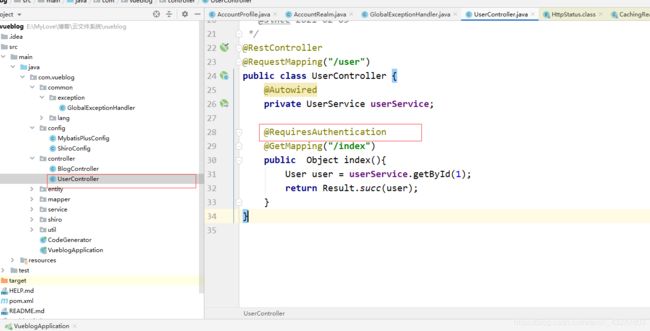
运行效果:
提示401登录异常

第六章 实体校验
当我们表单数据提交的时候,前端的校验我们可以使用一些类似于jQuery Validate等js插件实现,而后端我们可以使用Hibernate validatior来做校验。
我们使用springboot框架作为基础,那么就已经自动集成了Hibernate validatior。(校验登录非空等等)
- User实体类中
import javax.validation.constraints.Email;
import javax.validation.constraints.NotBlank;
....
@TableName("m_user")
public class User implements Serializable {
private static final long serialVersionUID = 1L;
@TableId(value = "id", type = IdType.AUTO)
private Long id;
@NotBlank(message = "昵称不能为空")
private String username;
@NotBlank(message = "邮箱不能为空")
@Email(message = "邮箱格式不正确")
private String email;
...
}
- 在userController类中写一个方法测试
/**
*
*@RequestBody主要用来接收前端传递给后端的json字符串中的数据的(请求体中的数据的);
* GET方式无请求体,所以使用@RequestBody接收数据时,
* 前端不能使用GET方式提交数据,
* 而是用POST方式进行提交。在后端的同一个接收方法里,
* @RequestBody与@RequestParam()可以同时使用,@RequestBody最多只能有一个,
* 而@RequestParam()可以有多个。
*
* @Validated注解用于检查user中填写的规则 如果不满足抛出异常
* 可在GlobalExceptionHandler中捕获此异常 进行自定义 返回数据信息
*/
@PostMapping("/save")
public Result save(@Validated @RequestBody User user){
return Result.succ(user);
}
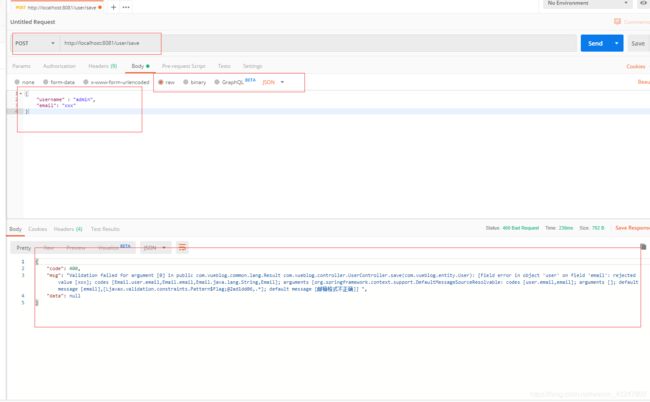
启动postMan测试
如果postman没法启动
可以新建一个环境变量POSTMAN_DISABLE_GPU = true。
1.打开高级系统设置;
2.在“高级”选项卡中,单击“环境变量”;
3.添加一个新的系统变量;
4.关闭Postman并重新打开
![]()
定义捕获异常返回处理
在捕获异常 GlobalExceptionHandler类中修改如下:
/**
* 实体校验异常
* MethodArgumentNotValidException捕获实体校验异常
*/
@ResponseStatus(HttpStatus.BAD_REQUEST) //因为前后端分离 返回一个状态
@ExceptionHandler(value = MethodArgumentNotValidException.class)//捕获运行时异常
public Result handler(MethodArgumentNotValidException e){
log.error("实体捕获异常 :-----------------{}",e);
BindingResult bindingException = e.getBindingResult();
//多个异常顺序抛出异常
ObjectError objectError = bindingException.getAllErrors().stream().findFirst().get();
return Result.fail(objectError.getDefaultMessage());
}
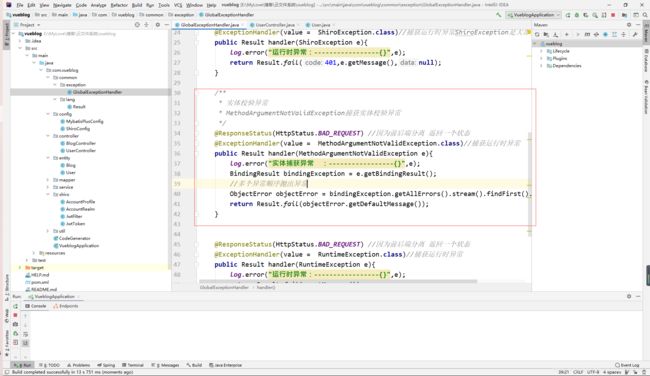
效果如下:(变得简短了)
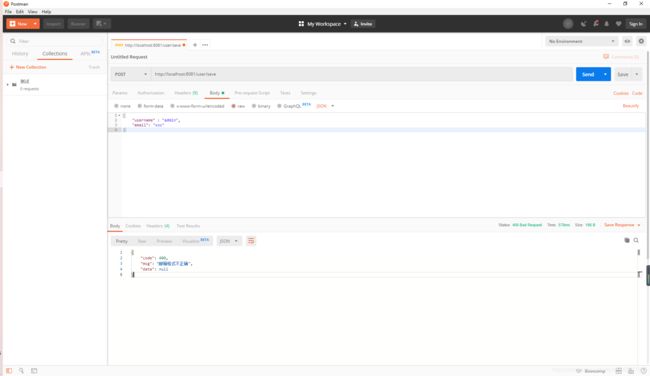
输入正确的格式如下:
返回了我们需要的信息
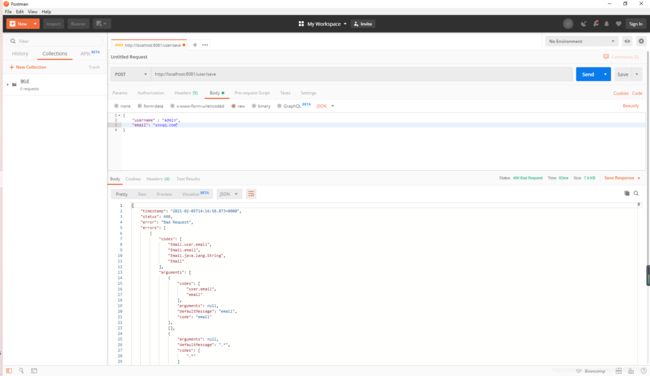
第七章 跨域问题
因为是前后端分析,所以跨域问题是避免不了的,我们直接在后台进行全局跨域处理:
路径:com.vueblog.config
注意:此配置是配置到confroller的,在confroller之前是经过jwtFilter,所以在进行访问之前配置一下Filter的跨域问题
package com.vueblog.config;
import org.springframework.context.annotation.Configuration;
import org.springframework.web.servlet.config.annotation.CorsRegistry;
import org.springframework.web.servlet.config.annotation.WebMvcConfigurer;
/**
* 解决跨域问题
*/
@Configuration
public class CorsConfig implements WebMvcConfigurer {
@Override
public void addCorsMappings(CorsRegistry registry) {
registry.addMapping("/**")
.allowedOrigins("*")
.allowedMethods("GET", "HEAD", "POST", "PUT", "DELETE", "OPTIONS")
.allowCredentials(true)
.maxAge(3600)
.allowedHeaders("*");
}
}
jwtFilter进行跨域处理:
- 路径:com.vueblog.shiro
/**
* 对跨域提供支持
* @param request
* @param response
* @return
* @throws Exception
*/
@Override
protected boolean preHandle(ServletRequest request, ServletResponse response) throws Exception {
HttpServletRequest httpServletRequest = WebUtils.toHttp(request);
HttpServletResponse httpServletResponse = WebUtils.toHttp(response);
httpServletResponse.setHeader("Access-control-Allow-Origin", httpServletRequest.getHeader("Origin"));
httpServletResponse.setHeader("Access-Control-Allow-Methods", "GET,POST,OPTIONS,PUT,DELETE");
httpServletResponse.setHeader("Access-Control-Allow-Headers", httpServletRequest.getHeader("Access-Control-Request-Headers"));
// 跨域时会首先发送一个OPTIONS请求,这里我们给OPTIONS请求直接返回正常状态
if (httpServletRequest.getMethod().equals(RequestMethod.OPTIONS.name())) {
httpServletResponse.setStatus(org.springframework.http.HttpStatus.OK.value());
return false;
}
return super.preHandle(request, response);
}
----基本框架已经搭建完成-----
第七章 登录接口开发
- 创建LoginDto
- 路径: com.vueblog.common.dto
package com.vueblog.common.dto;
import lombok.Data;
import javax.validation.constraints.NotBlank;
import java.io.Serializable;
@Data
public class LoginDto implements Serializable {
@NotBlank(message = "用户名不能为空")
private String username;
@NotBlank(message = "密码不能为空")
private String password;
}
- 在GlobalExceptionHandler类中增加断言异常
路径:com.vueblog.common.exception
/**
* 断言异常
* @param e
* @return
*/
@ResponseStatus(HttpStatus.BAD_REQUEST)
@ExceptionHandler(value = IllegalArgumentException.class)
public Result handler(IllegalArgumentException e){
log.error("Assert异常:------------------>{}",e);
return Result.fail(e.getMessage());
}
- 创建AccountController类
登录和退出逻辑
package com.vueblog.controller;
import cn.hutool.core.lang.Assert;
import cn.hutool.core.map.MapUtil;
import cn.hutool.crypto.SecureUtil;
import com.baomidou.mybatisplus.core.conditions.query.QueryWrapper;
import com.vueblog.common.dto.LoginDto;
import com.vueblog.common.lang.Result;
import com.vueblog.entity.User;
import com.vueblog.service.UserService;
import com.vueblog.util.JwtUtils;
import org.apache.shiro.SecurityUtils;
import org.apache.shiro.authz.annotation.RequiresAuthentication;
import org.springframework.beans.factory.annotation.Autowired;
import org.springframework.validation.annotation.Validated;
import org.springframework.web.bind.annotation.RequestBody;
import org.springframework.web.bind.annotation.RequestMapping;
import org.springframework.web.bind.annotation.RestController;
import javax.servlet.http.HttpServletResponse;
@RestController
public class AccountController {
@Autowired
UserService userService;
@Autowired
JwtUtils jwtUtils;
@RequestMapping("/login")
public Result login(@Validated @RequestBody LoginDto loginDto, HttpServletResponse response){
User user = userService.getOne(new QueryWrapper<User>().eq("username", loginDto.getUsername()));
Assert.notNull(user,"用户不存在");//断言拦截
//判断账号密码是否错误 因为是md5加密所以这里md5判断
if(!user.getPassword().equals(SecureUtil.md5(loginDto.getPassword()))){
//密码不同则抛出异常
return Result.fail("密码不正确");
}
String jwt = jwtUtils.generateToken(user.getId());
//将token 放在我们的header里面
response.setHeader("Authorization",jwt);
response.setHeader("Access-control-Expose-Headers","Authorization");
return Result.succ(MapUtil.builder()
.put("id",user.getId())
.put("username",user.getUsername())
.put("avatar",user.getAvatar())
.put("email",user.getEmail()).map()
);
}
//需要认证权限才能退出登录
@RequiresAuthentication
@RequestMapping("/logout")
public Result logout() {
//退出登录
SecurityUtils.getSubject().logout();
return null;
}
}
第八章 博客接口的开发
- 创建工具类ShiroUtil
路径om.vueblog.util,可于判断等等
package com.vueblog.util;
import com.vueblog.shiro.AccountProfile;
import org.apache.shiro.SecurityUtils;
public class ShiroUtil {
public static AccountProfile getProfile(){
return (AccountProfile) SecurityUtils.getSubject().getPrincipal();
}
}
- 完善BlogController类
package com.vueblog.controller;
import cn.hutool.core.bean.BeanUtil;
import cn.hutool.core.lang.Assert;
import com.baomidou.mybatisplus.core.conditions.query.QueryWrapper;
import com.baomidou.mybatisplus.core.metadata.IPage;
import com.baomidou.mybatisplus.extension.plugins.pagination.Page;
import com.vueblog.common.lang.Result;
import com.vueblog.entity.Blog;
import com.vueblog.service.BlogService;
import com.vueblog.util.ShiroUtil;
import org.apache.shiro.authz.annotation.RequiresAuthentication;
import org.springframework.beans.factory.annotation.Autowired;
import org.springframework.validation.annotation.Validated;
import org.springframework.web.bind.annotation.*;
import java.time.LocalDateTime;
/**
* <p>
* 前端控制器
* </p>
*
* @author 深林中的书海
* @since 2021-02-05
*/
@RestController
public class BlogController {
@Autowired
BlogService blogService;
//木有值默认为1
@GetMapping("/blogs")
public Result list(@RequestParam(defaultValue = "1") Integer currentPage){
Page page = new Page(currentPage, 5);
IPage pageData = blogService.page(page, new QueryWrapper<Blog>().orderByDesc("created"));
return Result.succ(pageData);
}
//@PathVariable动态路由
@GetMapping("/blog/{id}")
public Result detail(@PathVariable Long id){
Blog blog = blogService.getById(id);
//判断是否为空 为空则断言异常
Assert.notNull(blog,"该博客已被删除");
return Result.succ(blog);
}
//@Validated校验
//@RequestBody
//添加删除 木有id则添加 有id则编辑
@RequiresAuthentication //需要认证之后才能操作
@PostMapping("/blog/edit")
public Result edit(@Validated @RequestBody Blog blog){
//一个空对象用于赋值
Blog temp = null;
//如果有id则是编辑
if(blog.getId() != null){
temp = blogService.getById(blog.getId());//将数据库的内容传递给temp
//只能编辑自己的文章
Assert.isTrue(temp.getUserId().longValue()== ShiroUtil.getProfile().getId().longValue(),"没有编辑权限");
} else {
temp = new Blog();
temp.setUserId(ShiroUtil.getProfile().getId());
temp.setCreated(LocalDateTime.now());
temp.setStatus(0);
}
//将blog的值赋给temp 忽略 id userid created status 引用于hutool
BeanUtil.copyProperties(blog,temp,"id","userId","created","status");
blogService.saveOrUpdate(temp);
return Result.succ(null);
}
//@PathVariable动态路由
@RequiresAuthentication //需要认证之后才能操作
@PostMapping("/blogdel/{id}")
public Result del(@PathVariable Long id){
boolean b = blogService.removeById(id);
//判断是否为空 为空则断言异常
if(b==true){
return Result.succ("文章删除成功");
}else{
return Result.fail("文章删除失败");
}
}
}
- 运行程序
查询测试:

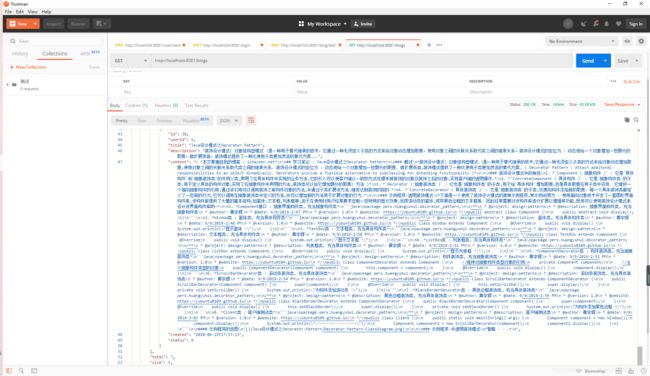
新增编辑测试:
得到token

选中header=>填写token
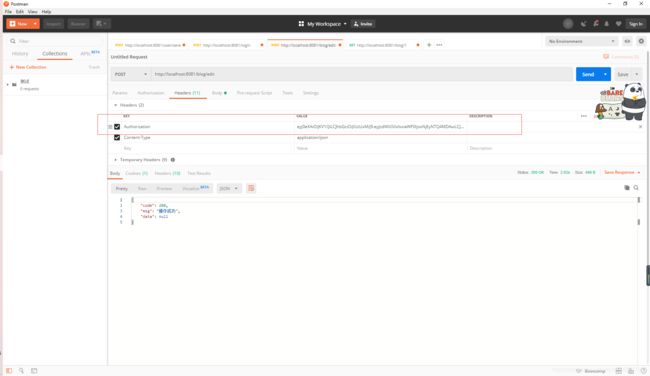
选中body=>raw=>json填写请求
新增
{
"title":"标题测试",
"description":"描述测试哦奥德萨",
"content":"内容测试阿斯顿撒哦i等哈送到哈桑"
}
{
"id":21,
"title":"标题测试修改",
"description":"描述测试哦奥德萨",
"content":"内容测试阿斯顿撒哦i等哈送到哈桑"
}
后端总结
后端的一个骨架基本完成然后开始我们的前端开发
第九章 Vue前端页面开发
前言
接下来,我们来完成vueblog前端的部分功能。可能会使用的到技术如下:
vue
element-ui
axios
mavon-editor
markdown-it
github-markdown-css
环境准备
- node.js安装:
- 接下来,我们安装vue的环境
# 安装淘宝npm
npm install -g cnpm --registry=https://registry.npm.taobao.org
# vue-cli 安装依赖包
cnpm install --g vue-cli
新建项目
选中要建立的文件cmd打开
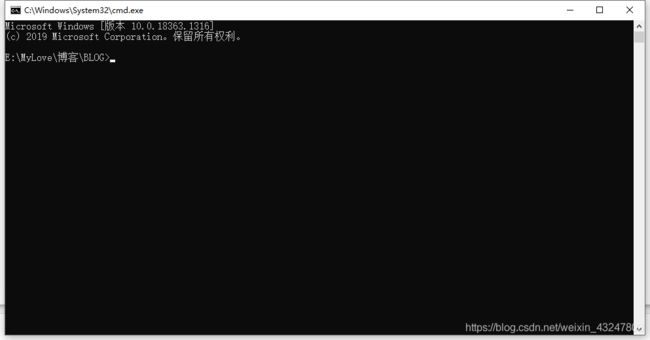
进入你的项目目录,创建一个基于 webpack 模板的新项目: vue init webpack 项目名
输入:
vue init webpack xx
全部enter即可
cd demo
npm run dev
项目的架构
├── README.md 项目介绍
├── index.html 入口页面
├── build 构建脚本目录
│ ├── build-server.js 运行本地构建服务器,可以访问构建后的页面
│ ├── build.js 生产环境构建脚本
│ ├── dev-client.js 开发服务器热重载脚本,主要用来实现开发阶段的页面自动刷新
│ ├── dev-server.js 运行本地开发服务器
│ ├── utils.js 构建相关工具方法
│ ├── webpack.base.conf.js wabpack基础配置
│ ├── webpack.dev.conf.js wabpack开发环境配置
│ └── webpack.prod.conf.js wabpack生产环境配置
├── config 项目配置
│ ├── dev.env.js 开发环境变量
│ ├── index.js 项目配置文件
│ ├── prod.env.js 生产环境变量
│ └── test.env.js 测试环境变量
├── mock mock数据目录
│ └── hello.js
├── package.json npm包配置文件,里面定义了项目的npm脚本,依赖包等信息
├── src 源码目录
│ ├── main.js 入口js文件
│ ├── app.vue 根组件
│ ├── components 公共组件目录
│ │ └── title.vue
│ ├── assets 资源目录,这里的资源会被wabpack构建
│ │ └── images
│ │ └── logo.png
│ ├── routes 前端路由
│ │ └── index.js
│ ├── store 应用级数据(state)状态管理
│ │ └── index.js
│ └── views 页面目录
│ ├── hello.vue
│ └── notfound.vue
├── static 纯静态资源,不会被wabpack构建。
└── test 测试文件目录(unit&e2e)
└── unit 单元测试
├── index.js 入口脚本
├── karma.conf.js karma配置文件
└── specs 单测case目录
└── Hello.spec.js
集成开发工具Visual Studio Code(VsCode)
vscode前端常用插件推荐,搭建JQuery、Vue等开发环境
汉化插件:chinese
插件如何导入和一些推荐插件:
https://blog.csdn.net/jiandan1127/article/details/85957003/
使用vscode打开项目并且运行
ctrl+`(~键)打开终端
输入:
npm run dev
安装element-ui
- 官方文档:
https://element.eleme.cn/#/zh-CN/component/installation
ctrl+`(~键)打开终端输入安装命令
# 安装element-ui
cnpm install element-ui --save
然后我们打开项目src目录下的main.js,引入element-ui依赖。
import Element from 'element-ui'
import "element-ui/lib/theme-chalk/index.css"
Vue.use(Element)
- 测试elementUi是否引入成功
import Vue from 'vue'
import Router from 'vue-router'
import HelloWorld from '@/components/HelloWorld'
import Demo from '@/views/Demo'
Vue.use(Router)
export default new Router({
routes: [
{
path: '/',
name: 'HelloWorld',
component: HelloWorld
}, {
path: '/Demo',
name: 'Demo',
component: Demo
}
]
})
- 新建Demo.vue
src/views/demo
引入button按钮(官方直接复制)
<template>
<div class="Demo">
{
{
msg}}
<el-button type="primary">主要按钮</el-button>
</div>
</template>
<script>
export default{
name: "Demo",
data() {
return {
msg: "测试"
};
}
}
</script>
- App.vue添加:
<div id="nav">
<router-link to="/demo">Demo页面</router-link>
</div>
- 运行项目浏览器打开项目
- 显示下方则成功
补充配置:
autoOpenBrowser修改为true。
autoOpenBrowser:true
安装axios
接下来,我们来安装axios(www.axios-js.com/),axios是一个基于 promise 的 HTTP 库,这样我们进行前后端对接的时候,使用这个工具可以提高我们的开发效率。
- 安装命令:
cnpm install axios --save
- 然后同样我们在main.js中全局引入axios。
import axios from 'axios'
//引用全局
Vue.prototype.$axios = axios
页面路由
接下来,我们先定义好路由和页面,因为我们只是做一个简单的博客项目,页面比较少,所以我们可以直接先定义好,然后在慢慢开发,这样需要用到链接的地方我们就可以直接可以使用:
我们在views文件夹下定义几个页面:
BlogDetail.vue(博客详情页)
BlogEdit.vue(编辑博客)
Blogs.vue(博客列表)
Login.vue(登录页面)
可以配置插件:VueHelper(新建vue项目 最上方输入vuet按键tab可直接生成模板)
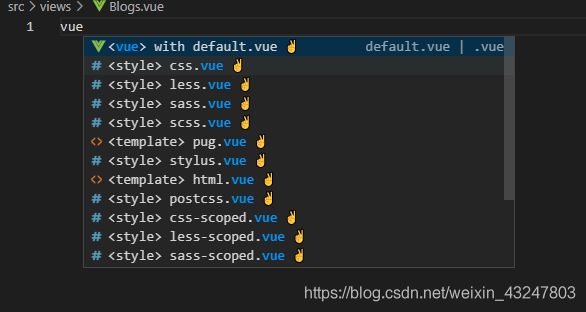
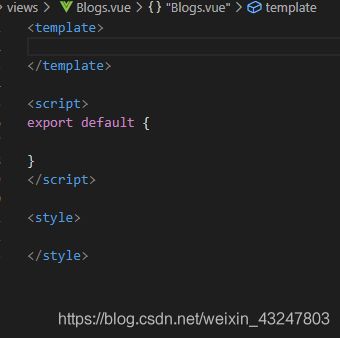
建立页面完成
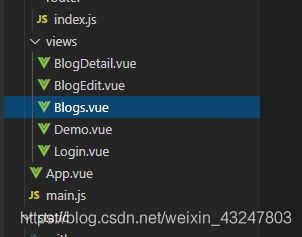
注意:每个页面下方 里面只能有一个
路由中心配置
路径:rountr/index.js
import Vue from 'vue'
import Router from 'vue-router'
import HelloWorld from '@/components/HelloWorld'
import Demo from '@/views/Demo'
import Login from '@/views/Login'
import Blogs from '@/views/Blogs'
import BlogEdit from '@/views/BlogEdit'
import BlogDetail from '@/views/BlogDetail'
Vue.use(Router)
export default new Router({
routes: [
{
path: '/',
name: 'Index',
redirect:{
name : "Blogs"}
},
{
path: '/blogs',
name: 'Blogs',
component: Blogs
},{
path: '/Login',
name: 'Login',
component: Login
},{
path: '/blog/add',
name: 'BlogEdit',
component: BlogEdit
}, {
path: '/Demo',
name: 'Demo',
component: Demo
},{
path: '/blog/:blogid',
name: 'BlogDetail',
component: BlogDetail
} ,{
path: '/blog/:blogid/edit',
name: 'BlogEdit',
component: BlogEdit
}
]})
打开终端 npm run dev启动项目
可自行测试其他路由

测试完我们可以删掉App.vue中的测试和图片
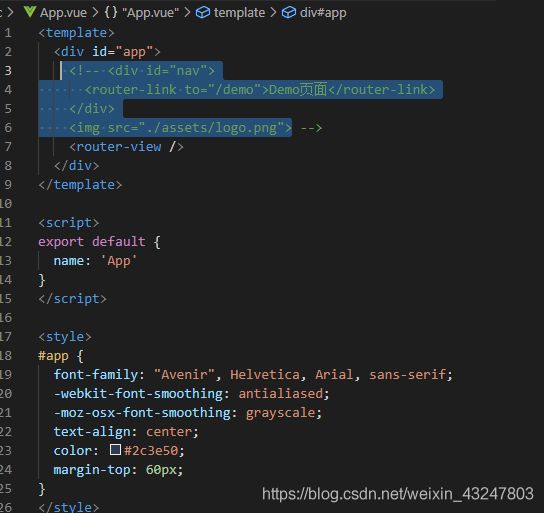
登录页面开发
登录页面制作
Login.vie
<template>
<div>
<el-container>
<el-header>
<img class="mlogo" src="../assets/logo.jpg" alt="logo图片" />
</el-header>
<el-main>
<el-form :model="ruleForm" :rules="rules" ref="ruleForm" label-width="100px" class="demo-ruleForm">
<el-form-item label="用户姓名" prop="username">
<el-input v-model="ruleForm.username"></el-input>
</el-form-item>
<el-form-item label="用户密码" prop="password">
<el-input v-model="ruleForm.password"></el-input>
</el-form-item>
<el-form-item>
<el-button type="primary" @click="submitForm('ruleForm')">立即创建</el-button>
<el-button @click="resetForm('ruleForm')">重置</el-button>
</el-form-item>
</el-form>
</el-main>
</el-container>
</div>
</template>
<script>
export default {
name: "Login",
data () {
return {
ruleForm: {
username: '',
password: ''
},
rules: {
username: [
{
required: true, message: '请输入用户名称', trigger: 'blur' },
{
min: 3, max: 15, message: '长度在 3 到 15 个字符', trigger: 'blur' }
],
password: [
{
required: true, message: '请选择密码', trigger: 'blur' }
]
}
};
},
methods: {
submitForm (formName) {
this.$refs[formName].validate((valid) => {
if (valid) {
alert('submit!');
} else {
console.log('error submit!!');
return false;
}
});
},
resetForm (formName) {
this.$refs[formName].resetFields();
}
}
}
</script>
<style scoped>
.el-header,
.el-footer {
background-color: #b3c0d1;
color: #333;
text-align: center;
line-height: 60px;
}
.el-main {
/* background-color: #e9eef3; */
color: #333;
text-align: center;
line-height: 160px;
}
.mlogo {
height: 80%;
}
.demo-ruleForm {
max-width: 500px;
margin: 0 auto;
}
</style>
配置store
在src包下面创建stroe文件夹
然后创建index.js
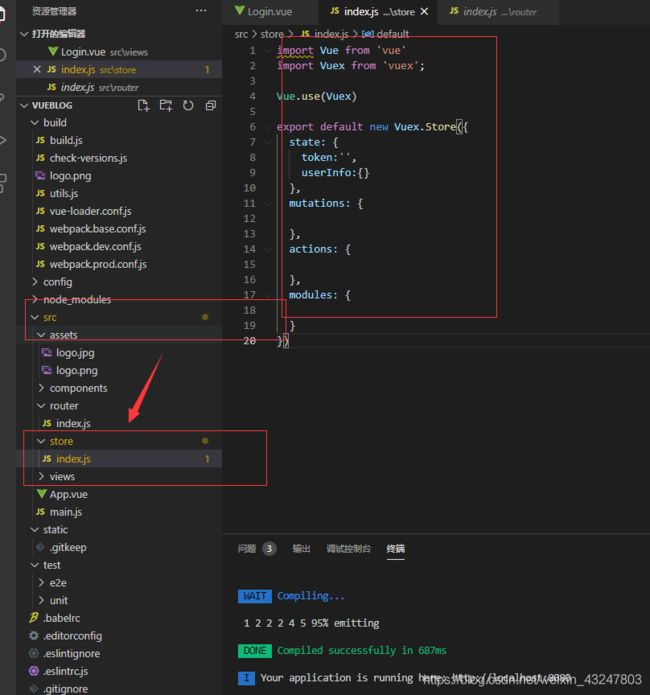
import Vue from 'vue'
import Vuex from 'vuex';
Vue.use(Vuex)
export default new Vuex.Store({
state: {
token:'',
userInfo:{
}
},
mutations: {
},
actions: {
},
modules: {
}
})
然后我们给main.js中引入store
// 存储
import store from './store'
//在new Vue({
}) 里面加入store
new Vue({
el: '#app',
router,
store ,
components: {
App },
template: '// The Vue build version to load with the `import` command
// (runtime-only or standalone) has been set in webpack.base.conf with an alias.
import Vue from 'vue'
import App from './App'
// 存储
import store from './store'
// 路由
import router from './router'
// 引入element-ui依赖
import Element from 'element-ui'
import "element-ui/lib/theme-chalk/index.css"
// 引入axios依赖
import axios from 'axios'
//引用全局
Vue.prototype.$axios = axios
Vue.use(Element)
Vue.config.productionTip = false
/* eslint-disable no-new */
new Vue({
el: '#app',
router,
store ,
components: {
App },
template: '** npm run dev启动测试**
登录发起请求 (配置完善store)
配置完善store/index.js
在store下面的index.js添加*
mutationsx相当于java中实体类的set
getters相当于get
> userInfo可以存入会话的sessionStorage里面
> **sessionStorage中只能存字符串 不能存入对象所以我们存入序列化 jons串:**
> **sessionStorage.setItem("userInfo",JSON.stringify(userInfo))**
> 会话获取
> **sessionStorage.getInte(userInfo)**
> token可以存入浏览器的localStorage里面
> localStorage.setItem("token",token)
> token获取:
> localStorage.getItem("token")
import Vue from 'vue'
import Vuex from 'vuex'
Vue.use(Vuex)
export default new Vuex.Store({
//定义全局参数 其他页面可以直接获取state里面的内容
state: {
token: '', //方法一 localStorage.getItem("token")
//反序列化获取session会话中的 userInfo对象
userInfo:JSON.parse(sessionStorage.getItem("userInfo"))
},
mutations: {
//相当于实体类的set
SET_TOKEN:(state,token)=>{
state.token=token//将传入的token赋值 给state的token
//同时可以存入浏览器的localStorage里面
localStorage.setItem("token",token)
},
SET_USERINFO:(state,userInfo)=>{
state.userInfo=userInfo//将传入的tuserInfo赋值 给state的userInfo
//同时可以存入会话的sessionStorage里面 sessionStorage中只能存字符串 不能存入对象所以我们存入序列化 jons串
sessionStorage.setItem("userInfo",JSON.stringify(userInfo))
},
//删除token及userInfo
REMOVE_INFO:(state)=>{
state.token = '';
state.userInfo = {
};
localStorage.setItem("token",'')
sessionStorage.setItem("userInfo",JSON.stringify(''))
}
},
getters: {
//相当于get
//配置一个getUser可以直接获取已经反序列化对象的一个userInfo
getUser: state=>{
return state.userInfo;
},getToken: state=>{
return state.token;
}
},
actions: {
},
modules: {
}
})
在Login.vue中添加
_this.$axios.post("http://localhost:8081/login", _this.ruleForm).then(res => {
console.log(res)
const jwt = res.headers['authorization'];
const userInfo = res.data.data
_this.$store.commit('SET_TOKEN', token)
_this.$store.commit('SET_USERINFO', userInfo)
})
<template>
<div>
<el-container>
<el-header>
<img class="mlogo" src="../assets/logo.jpg" alt="logo图片" />
</el-header>
<el-main>
<el-form :model="ruleForm" :rules="rules" ref="ruleForm" label-width="100px" class="demo-ruleForm">
<el-form-item label="用户姓名" prop="username">
<el-input v-model="ruleForm.username"></el-input>
</el-form-item>
<el-form-item label="用户密码" prop="password">
<el-input v-model="ruleForm.password"></el-input>
</el-form-item>
<el-form-item>
<el-button type="primary" @click="submitForm('ruleForm')">立即创建</el-button>
<el-button @click="resetForm('ruleForm')">重置</el-button>
</el-form-item>
</el-form>
</el-main>
</el-container>
</div>
</template>
<script>
export default {
name: "Login",
data () {
return {
ruleForm: {
username: 'admin',
password: '111111'
},
rules: {
username: [
{
required: true, message: '请输入用户名称', trigger: 'blur' },
{
min: 3, max: 15, message: '长度在 3 到 15 个字符', trigger: 'blur' }
],
password: [
{
required: true, message: '请选择密码', trigger: 'blur' }
]
}
};
},
methods: {
submitForm (formName) {
this.$refs[formName].validate((valid) => {
if (valid) {
const _this = this;//获取整个vue的this
console.log("校验成功")
// alert('submit!');
_this.$axios.post("http://localhost:8081/login", _this.ruleForm).then(res => {
console.log(res)
const jwt = res.headers['authorization'];
const userInfo = res.data.data
//存储(共享)全局变量jwt和userInfo
_this.$store.commit("SET_TOKEN", jwt);
_this.$store.commit("SET_USERINFO", userInfo);
//获取token和getUser
// console.log(_this.$store.getters.getToken)
// console.log(_this.$store.getters.getUser)
})
} else {
console.log('error submit!!');
return false;
}
});
},
resetForm (formName) {
this.$refs[formName].resetFields();
}
}
}
</script>
<style scoped>
.el-header,
.el-footer {
background-color: #b3c0d1;
color: #333;
text-align: center;
line-height: 60px;
}
.el-main {
/* background-color: #e9eef3; */
color: #333;
text-align: center;
line-height: 160px;
}
.mlogo {
height: 80%;
}
.demo-ruleForm {
max-width: 500px;
margin: 0 auto;
}
</style>
配置axios拦截
- src下面创建axios.js
- main.js中引入
// 引入自定义axios.js
import "./axios.js"
- 完善axios.js
// 引入axios依赖
import axios from 'axios'
// 引入element-ui依赖
import Element from 'element-ui'
import store from './store';
// 引入路由
import router from './router'
var s=window.location.toString();
var s1=s.substr(7,s.length);
var s2=s1.indexOf("/");
s=s.substr(0,8+s2);
var a = "http://localhost:8081/";//获取连接前缀相当于 http://localhost:8081/
//配置默认前缀
axios.defaults.baseURL= a
//配置前置拦截
axios.interceptors.request.use(config => {
return config
})
//配置后置拦截
axios.interceptors.response.use(response=>{
let res = response.data;
if(res.code == 200){
return response
}else{
Element.Message.error("操作错了哦",{
duration : 2*1000})
//返回一个异常提示就不会继续往下走了 不+的话 res=>的里面 还是会继续走的
return Promise.reject(response.data.msg)
}
// 捕获并处理后台异常信息
},error=>{
// 使得异常信息更加友好
console.log(error)
if (error.response.data) {
//data不为空时
error.message = error.response.data.msg
console.log("-------------------------")
console.log(error.message)
console.log("-------------------------")
}
if(error.response.status == 401){
store.commit('REMOVE_INFO')//清空token userinfo
router.push("/login") //跳转登录页面
}
Element.Message.error(error.message)
return Promise.reject(error)
}
)
- npm run dev运行效果
公共组件Header
要先打开在logout方法里面返回一个Result 不然会报错
![]()
如果报错了这个需要先安装redis并且启动
https://www.cnblogs.com/pretty-sunshine/p/10615287.html![]()
完善配置Header组件
<template>
<div class="m-content">
<h3>欢迎来到我的博客世界</h3>
<div class="block">
<div class="block">
<el-avatar :size="50" :src="user.avatar"></el-avatar>
</div>
<div>{
{
user.username}}</div>
<div class="maction">
<span>
<el-link>主页</el-link>
</span>
<el-divider direction="vertical"></el-divider>
<span>
<el-link type="success">发表博客</el-link>
</span>
<el-divider direction="vertical"></el-divider>
<span v-show="!hasLogin">
<el-link type="primary" @click="login">登录</el-link>
</span>
<span v-show="hasLogin">
<el-link type="danger" @click="logout">退出</el-link>
</span>
</div>
</div>
</div>
</template>
<script>
export default {
name: "Header"
, data () {
return {
user: {
username: '请先登录',
avatar: '../assets/logo.png'
},
hasLogin: false
}
},
methods: {
//退出操作
logout () {
const _this = this
//首先调用后端logout接口(因该接口需要认证权限,所以需要传入token)
//其次调用$store清除用户信息及token
_this.$axios.get("/logout", {
headers: {
"Authorization": localStorage.getItem("token")
}
}).then(res => {
_this.$store.commit("REMOVE_INFO")
_this.$router.push("/login")
})
},
login () {
//跳转登录页面进行登录
this.$router.push("/login")
}
},
//页面创建时即会调用,进而获取用户信息
created () {
console.log("=======123=")
console.log(this.$store.getters.getUser)
if (this.$store.getters.getUser.username) {
//如果username不为空
this.user.username = this.$store.getters.getUser.username
this.user.avatar = this.$store.getters.getUser.avatar
//判断是登录状态还是非登录显示 退出按钮或者登录按钮
this.hasLogin = true;
}
}
}
</script>
<style>
.m-content {
max-width: 960px;
margin: 0 auto;
text-align: center;
}
.maction {
}
</style>
运行项目可以自行测试登录退出功能
- 完善blogs.vue
先给实体类Blog加上JsonFormat
@JsonFormat(pattern = "yyyy-MM-dd HH:mm:ss")
private LocalDateTime created;
- 完善Blogs.vue
<template>
<div class="mcontaner">
<Header></Header>
<div class="block">
<el-timeline>
<el-timeline-item :timestamp="blog.created" placement="top" v-for="(blog,key) in blogs" :key=key>
<el-card>
<h4>
<router-link :to="{ name: 'BlogDetail', params: {blogid: blog.id}}">{
{
blog.title}}</router-link>
</h4>
<p>{
{
blog.description}}</p>
</el-card>
</el-timeline-item>
</el-timeline>
<el-pagination class="mage" background layout="prev, pager, next" :current-page="currentPage"
:page-size="pageSize" :total="total" @current-change=page>
</el-pagination>
</div>
</div>
</template>
<script>
//引入header组件
import Header from "../components/Header";
export default {
data () {
return {
blogs: {
},
currentPage: 1,
total: 0,
pageSize: 5
}
},
name: "Blogs",
components: {
Header },
methods: {
page (currentPage) {
const _this = this
_this.$axios.get("/blogs?currentPage=" + currentPage).then(res => {
var data = res.data.data
_this.blogs = data.records
_this.currentPage = data.current
_this.pageSize = data.size
_this.total = data.total
})
}
},
created () {
this.page(1)
}
}
</script>
<style scoped>
.block {
margin: 20px;
}
.mage {
margin: 0 auto;
}
</style>
博客编辑(发表)
安装mavon-editor
- 基于Vue的markdown编辑器mavon-editor
cnpm install mavon-editor --save
- 然后在main.js中全局注册:
// 全局注册
import mavonEditor from 'mavon-editor'
import 'mavon-editor/dist/css/index.css'
// use
Vue.use(mavonEditor)
// The Vue build version to load with the `import` command
// (runtime-only or standalone) has been set in webpack.base.conf with an alias.
import Vue from 'vue'
import App from './App'
// 存储
import store from './store'
// 路由
import router from './router'
// 引入element-ui依赖
import Element from 'element-ui'
import "element-ui/lib/theme-chalk/index.css"
// 引入axios依赖
import axios from 'axios'
// 引入自定义axios.js
import "./axios.js"
//mavonEditor
import mavonEditor from 'mavon-editor'
import 'mavon-editor/dist/css/index.css'
//引用全局
Vue.prototype.$axios = axios
// use
Vue.use(mavonEditor)
Vue.use(Element)
Vue.config.productionTip = false
/* eslint-disable no-new */
new Vue({
el: '#app',
router,
store ,
components: {
App },
template: '编写BlogEdit.vue
<template>
<div>
<Header></Header>
<div class="m-content">
<el-form :model="ruleForm" :rules="rules" ref="ruleForm" label-width="100px" class="demo-ruleForm">
<el-form-item label="标题" prop="title">
<el-input v-model="ruleForm.title"></el-input>
</el-form-item>
<el-form-item label="摘要" prop="description">
<el-input type="textarea" v-model="ruleForm.description"></el-input>
</el-form-item>
<el-form-item label="内容" prop="content">
<mavon-editor v-model="ruleForm.content"></mavon-editor>
</el-form-item>
<el-form-item>
<el-button type="primary" @click="submitForm('ruleForm')">立即创建</el-button>
<el-button @click="resetForm('ruleForm')">重置</el-button>
</el-form-item>
</el-form>
</div>
</div>
</template>
<script>
import Header from "../components/Header";
export default {
name: "BlogEdit",
components: {
Header },
data () {
return {
ruleForm: {
id: '',
title: '',
description: '',
content: ''
},
rules: {
title: [
{
required: true, message: '请输入标题', trigger: 'blur' },
{
min: 3, max: 5, message: '长度在 3 到 15 个字符', trigger: 'blur' }
],
description: [
{
required: true, message: '请输入摘要', trigger: 'blur' },
],
content: [
{
required: true, message: '请输入内容', trigger: 'blur' },
]
}
};
},
methods: {
submitForm (formName) {
this.$refs[formName].validate((valid) => {
if (valid) {
const _this = this
this.$axios.post('/blog/edit', this.ruleForm, {
headers: {
"Authorization": localStorage.getItem("token")
}
}).then(res => {
_this.$alert('操作成功', '提示', {
confirmButtonText: '确定',
callback: action => {
_this.$router.push("/blogs")
}
});
})
} else {
console.log('error submit!!');
return false;
}
});
},
resetForm (formName) {
this.$refs[formName].resetFields();
}
},
created () {
//获取动态路由的 blogid
const blogId = this.$route.params.blogid
console.log(blogId)
const _this = this
if (blogId) {
this.$axios.get("/blog/" + blogId).then(res => {
console.log(res)
const blog = res.data.data
_this.ruleForm.id = blog.id
_this.ruleForm.title = blog.title
_this.ruleForm.description = blog.description
_this.ruleForm.content = blog.content
})
}
}
}
</script>
<style scoped>
.m-content {
text-align: center;
}
</style>
博客详情和编辑按钮的权限
博客详情中需要回显博客信息,然后有个问题就是,后端传过来的是博客内容是markdown格式的内容,我们需要进行渲染然后显示出来,这里我们使用一个插件markdown-it,用于解析md文档,然后导入github-markdown-c,所谓md的样式。
# 用于解析md文档
cnpm install markdown-it --save
# md样式
cnpm install github-markdown-css
然后就可以在需要渲染的地方使用:
- views\BlogDetail.vue
<template>
<div>
<Header></Header>
<div class="blog">
<h2>{
{
blog.title}}</h2>
<el-link icon="el-icon-edit" v-if="ownblog">
<router-link :to="{name:'BlogEdit',params:{blogid:blog.id}}">
编辑
</router-link>
</el-link>
<el-divider></el-divider>
<div class="markdown-body" v-html="blog.content"></div>
</div>
</div>
</template>
<script>
import 'github-markdown-css'
import Header from "../components/Header";
export default {
name: "BlogDetail",
components: {
Header },
data () {
return {
blog: {
id: '',
title: '',
content: '',
description: ''
},
ownblog: false
}
},
created () {
//获取动态路由的 blogid
const blogId = this.$route.params.blogid
const _this = this
if (blogId) {
this.$axios.get("/blog/" + blogId).then(res => {
const blog = res.data.data
_this.blog.id = blog.id
_this.blog.title = blog.title
_this.blog.description = blog.description
//MardownIt 渲染
var MardownIt = require("markdown-it")
var md = new MardownIt();
var result = md.render(blog.content)
_this.blog.content = result
//查看是否是登录人 是则可以编辑
_this.ownBlog = (blog.userId === _this.$store.getters.getUser.id)
})
}
}
}
</script>
<style scoped>
.blog {
margin-top: 10px;
box-shadow: 0 2px 12px 0 rgba(0, 0, 0, 0.1);
width: 100%;
min-height: 700px;
padding: 10px;
}
</style>
路由权限拦截
页面已经开发完毕之后,我们来控制一下哪些页面是需要登录之后才能跳转的,如果未登录访问就直接重定向到登录页面,因此我们在src目录下定义一个js文件:
//配置一个路由前置拦截 rounter是路由
- src\permission.js
import router from "./router";
// 路由判断登录 根据路由配置文件的参数
router.beforeEach((to, from, next) => {
if (to.matched.some(record => record.meta.requireAuth)) {
// 判断该路由是否需要登录权限
const token = localStorage.getItem("token")
console.log("------------" + token)
if (token) {
// 判断当前的token是否存在 ; 登录存入的token
if (to.path === '/login') {
} else {
next()
}
} else {
next({
path: '/login'
})
}
} else {
next()
}
})
通过之前我们再定义页面路由时候的的meta信息,指定requireAuth: true,需要登录才能访问,因此这里我们在每次路由之前(router.beforeEach)判断token的状态,觉得是否需要跳转到登录页面。
- src/rouer/index.js
添加:
meta: {
requireAuth: true
}
{
path: '/blog/add', // 注意放在 path: '/blog/:blogId'之前
name: 'BlogAdd',
meta: {
requireAuth: true
},
component: BlogEdit
},{
path: '/blog/:blogid/edit',
name: 'BlogEdit',
component: BlogEdit,
meta: {
requireAuth: true
}
import Vue from 'vue'
import Router from 'vue-router'
import HelloWorld from '@/components/HelloWorld'
import Demo from '@/views/Demo'
import Login from '@/views/Login'
import Blogs from '@/views/Blogs'
import BlogEdit from '@/views/BlogEdit'
import BlogDetail from '@/views/BlogDetail'
Vue.use(Router)
export default new Router({
routes: [
{
path: '/',
name: 'Index',
redirect:{
name : "Blogs"}
},
{
path: '/blogs',
name: 'Blogs',
component: Blogs
},{
path: '/Login',
name: 'Login',
component: Login
},{
path: '/blog/add',
name: 'BlogEdit',
component: BlogEdit,
meta: {
requireAuth: true
}
}, {
path: '/Demo',
name: 'Demo',
component: Demo
},{
path: '/blog/:blogid',
name: 'BlogDetail',
component: BlogDetail
} ,{
path: '/blog/:blogid/edit',
name: 'BlogEdit',
component: BlogEdit,
meta: {
requireAuth: true
}
}
]})
然后我们再main.js中import我们的permission.js
- src/main.js
添加: import ‘./permission.js’ // 路由拦截
// The Vue build version to load with the `import` command
// (runtime-only or standalone) has been set in webpack.base.conf with an alias.
import Vue from 'vue'
import App from './App'
// 存储
import store from './store'
// 路由
import router from './router'
// 引入element-ui依赖
import Element from 'element-ui'
import "element-ui/lib/theme-chalk/index.css"
// 引入axios依赖
import axios from 'axios'
// 引入自定义axios.js
import "./axios.js"
import './permission.js' // 路由拦截
//mavonEditor
import mavonEditor from 'mavon-editor'
import 'mavon-editor/dist/css/index.css'
//引用全局
Vue.prototype.$axios = axios
// use
Vue.use(mavonEditor)
Vue.use(Element)
Vue.config.productionTip = false
/* eslint-disable no-new */
new Vue({
el: '#app',
router,
store ,
components: {
App },
template: '第十章 其他
增加删除文章功能
- 前端
src/views/BlogDetail.vue
<template>
<div>
<Header></Header>
<div class="blog">
<h2>{
{
blog.title}}</h2>
<el-link icon="el-icon-edit" v-if="ownblog" class="linklist">
<router-link :to="{name:'BlogEdit',params:{blogid:blog.id}}">
编辑
</router-link>
</el-link>
<el-link icon="el-icon-delete" v-if="ownblog" class="linklist">
<el-button type="danger" round @click="delblog">删除</el-button>
</el-link>
<el-divider></el-divider>
<div class="markdown-body" v-html="blog.content"></div>
</div>
</div>
</template>
<script>
import 'github-markdown-css'
import Header from "../components/Header";
export default {
name: "BlogDetail",
components: {
Header },
data () {
return {
blog: {
id: '',
title: '',
content: '',
description: ''
},
ownblog: false
}
},
methods: {
delblog () {
const blogId = this.$route.params.blogid
const _this = this
if (blogId) {
this.$confirm('此操作将永久删除该文章, 是否继续?', '提示', {
confirmButtonText: '确定',
cancelButtonText: '取消',
type: 'warning'
}).then(() => {
_this.$axios.post(`/blogdel/${
blogId}`, null, {
headers: {
"Authorization": localStorage.getItem("token")
}
}).then(res => {
this.$message({
type: 'success',
message: res.data.data
});
_this.$router.push("/blogs")
})
}).catch(() => {
this.$message({
type: 'info',
message: '已取消删除'
});
});
}
}
},
created () {
//获取动态路由的 blogid
const blogId = this.$route.params.blogid
const _this = this
if (blogId) {
this.$axios.get("/blog/" + blogId).then(res => {
const blog = res.data.data
_this.blog.id = blog.id
_this.blog.title = blog.title
_this.blog.description = blog.description
//MardownIt 渲染
var MardownIt = require("markdown-it")
var md = new MardownIt();
var result = md.render(blog.content)
_this.blog.content = result
//查看是否是登录人 是则可以编辑和删除
_this.ownblog = (blog.userId === _this.$store.getters.getUser.id)
})
}
}
}
</script>
<style scoped>
.blog {
margin-top: 10px;
box-shadow: 0 2px 12px 0 rgba(0, 0, 0, 0.1);
width: 100%;
min-height: 700px;
padding: 10px;
}
.linklist {
margin: 5px;
}
</style>
- 后端
src/main/java/com/vuelog/controller/BlogController
//@PathVariable动态路由
@RequiresAuthentication //需要认证之后才能操作
@PostMapping("/blogdel/{id}")
public Result del(@PathVariable Long id){
boolean b = blogService.removeById(id);
//判断是否为空 为空则断言异常
if(b==true){
return Result.succ("文章删除成功");
}else{
return Result.fail("文章删除失败");
}
}
package com.vueblog.controller;
import cn.hutool.core.bean.BeanUtil;
import cn.hutool.core.lang.Assert;
import com.baomidou.mybatisplus.core.conditions.query.QueryWrapper;
import com.baomidou.mybatisplus.core.metadata.IPage;
import com.baomidou.mybatisplus.extension.plugins.pagination.Page;
import com.vueblog.common.lang.Result;
import com.vueblog.entity.Blog;
import com.vueblog.service.BlogService;
import com.vueblog.util.ShiroUtil;
import org.apache.shiro.authz.annotation.RequiresAuthentication;
import org.springframework.beans.factory.annotation.Autowired;
import org.springframework.validation.annotation.Validated;
import org.springframework.web.bind.annotation.*;
import java.time.LocalDateTime;
/**
* <p>
* 前端控制器
* </p>
*
* @author 深林中的书海
* @since 2021-02-05
*/
@RestController
public class BlogController {
@Autowired
BlogService blogService;
//木有值默认为1
@GetMapping("/blogs")
public Result list(@RequestParam(defaultValue = "1") Integer currentPage){
Page page = new Page(currentPage, 5);
IPage pageData = blogService.page(page, new QueryWrapper<Blog>().orderByDesc("created"));
return Result.succ(pageData);
}
//@PathVariable动态路由
@GetMapping("/blog/{id}")
public Result detail(@PathVariable Long id){
Blog blog = blogService.getById(id);
//判断是否为空 为空则断言异常
Assert.notNull(blog,"该博客已被删除");
return Result.succ(blog);
}
//@Validated校验
//@RequestBody
//添加删除 木有id则添加 有id则编辑
@RequiresAuthentication //需要认证之后才能操作
@PostMapping("/blog/edit")
public Result edit(@Validated @RequestBody Blog blog){
//一个空对象用于赋值
Blog temp = null;
//如果有id则是编辑
if(blog.getId() != null){
temp = blogService.getById(blog.getId());//将数据库的内容传递给temp
//只能编辑自己的文章
Assert.isTrue(temp.getUserId().longValue()== ShiroUtil.getProfile().getId().longValue(),"没有编辑权限");
} else {
temp = new Blog();
temp.setUserId(ShiroUtil.getProfile().getId());
temp.setCreated(LocalDateTime.now());
temp.setStatus(0);
}
//将blog的值赋给temp 忽略 id userid created status 引用于hutool
BeanUtil.copyProperties(blog,temp,"id","userId","created","status");
blogService.saveOrUpdate(temp);
return Result.succ(null);
}
//@PathVariable动态路由
@RequiresAuthentication //需要认证之后才能操作
@PostMapping("/blogdel/{id}")
public Result del(@PathVariable Long id){
boolean b = blogService.removeById(id);
//判断是否为空 为空则断言异常
if(b==true){
return Result.succ("文章删除成功");
}else{
return Result.fail("文章删除失败");
}
}
}



